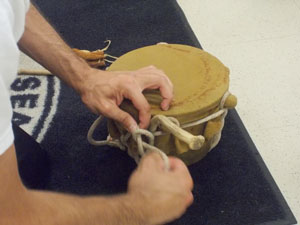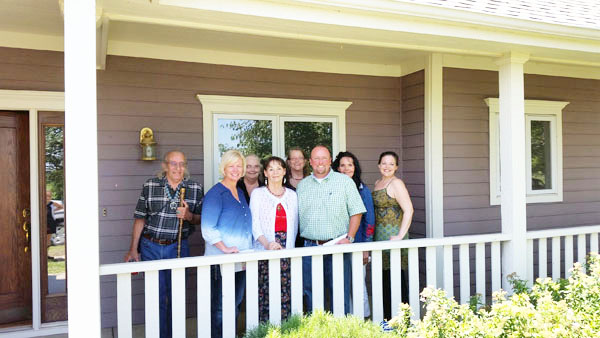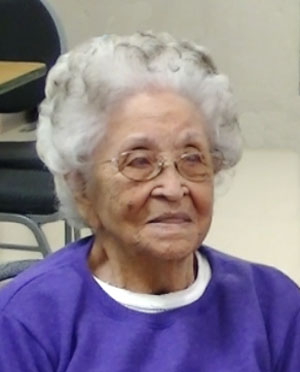Archives
now browsing by author
Update Your Cobell Status
Follow this link and select Cherokee Delaware Tribe (we don’t like it either) to find a list of people the Cobell lawyers are deeming “Lost,” then follow the instructions on the website to correct your status. Please remember that the Garden City Group attorneys got their info from the Department of Interior, NOT from the Tribe. You must contact them, NOT us.
https://secure.gcginc.com/iim-missingpersons/PersonSearch.aspx?state=OK
We are finding that a vast number of these names are also on the Delaware Tribe’s Missing Address List, most due to the fact that they had married and taken a different name. So please everyone take a look at this site and email us your new address at updates@delawaretribe.org if you happen to be on the list.
Veterans Committee to Auction Items at Delaware Days
Delaware Veterans Committee accepting cash or items to be auctioned Sept. 27th during Delaware Days at the Fallleaf Pow Wow grounds between Caney and Copan at the Chet Brooks and Joe Brooks camp at 3:00 P.M.
* Proceeds to be used for equipment for Color Guard & Burial Detail *
Questions or donations:
Contact Homer Scott Jr., 918-332-8020
Send in Your Absentee Ballot Request

If you did not vote in the 2013 Election you will need to send in an Absentee Ballot Request Form. All forms must be sent by U.S.P.S. and be received by close of business on October 1, 2014.
https://delawaretribe.org/wp-content/uploads/Absentee-Ballot-Request-Form.pdf
Mail the completed form to:
Delaware Election Board
PO Box 1198
Bartlesville, OK 74005
For further information please contact the Election Board by email at electionboard@delawaretribe.org or reach them at the voice mailbox at (918) 337-6586
Fond Farewell to Chris Miller
It is a sad day as we bid farewell to friend and colleague Chris Miller. Many of you have gotten to know Chris through his service to the Tribe in the Housing Department, as an Administrative Assistant, and most recently as Enrollment Clerk. In his three short years here he has made himself such an integral part the Tribe’s day-to-day functions and he has touched many of your lives through his dedication, caring and knowledge. We know he will be sorely missed by all but we must congratulate Chris on the opportunity he’s been offered and wish him the best as he moves on to another chapter of his life, and, as he has been there for all of us so too will we continue to be there for him. Good luck Chris!
Delaware Tribe to Hold Housing Seminar

On Tuesday, Aug. 19, the Delaware Tribe will host a Housing Seminar at the Delaware Tribal Complex, 170 NE Barbara, Bartlesville, Okla., in Forsythe Hall at the Community Center at 6 p.m.
The seminar, presented by Legacy Tribal Consultants, will provide details of the Section 184 Native American Home Loan program. This event is free and open to the public. A question and answer session will follow the presentation.
The Section 184 loan program offers competitive, low mortgage interest rates for: home purchase, refinance, rehab or construction including double-wide and modular homes — and loans are not limited to property on tribal lands.
Approved borrowers must be members of a federally recognized tribe with photo I.D. and tribal registration card.
Unlike traditional loan programs which are credit-score driven, Section 184 loans do not require a particular credit score. Instead, borrowers must demonstrate a pattern of good rental or mortgage history for the past two years, have all credit collections, judgments and tax liens paid, and have two years of work history in the same line of work and/or school enrollment.
Approved borrowers must be currently employed with verified income and those with past credit problems must provide written explanations of derogatory credit.
The loan program, guaranteed by the Dept. of Housing and Urban Development (HUD), has lower down-payment requirements than traditional loan programs. The Section 184 loan program offers borrower down payments of only 2.25% for mortgages over $50,000 and just 1.25% for mortgages under $50,000.
In addition, the source of down payment funds may be: borrower’s own funds, gift funds, secured loan funds or tribal down payment assistance.
Another attractive feature of the Section 184 loan program is that in purchase scenarios, contracts may specify that sellers pay prepaid fees, such as taxes and insurance, and other costs at the home closing. For more information, call the Delaware Tribe of Indians at 918-337-6590.
# # #
Press Release Prepared by: Roseanne McKee, McKee Public Relations on behalf of the Delaware Tribe of Indians with permission of Chief Paula Pechonick.
Contact info: mckeepr@outlook.com or the Delaware Tribe of Indians: 918-337-6590.
Delaware Water Drum


On July 8, at 6 p.m., a group of Delaware men met, as they often do on Tuesday nights, at the Delaware Community Center to drum and sing. This particular evening was special because elder, Dee Ketchum, was teaching Bear Tompkins, who is 25, how to tie the water drum for the first time.
First, a piece of buckskin is wet and stretched over a small brass kettle. The brass kettle is then filled about one-quarter full with water.
“One of the Jackson boys gave me these stones. We tie [the drum] off with the seven,” Dee Ketchum said.
According to Ketchum, the perfect number of the ancestors was seven. When the drum is finished, there should be a seven-point star on the bottom of the kettle made from the rope crossing back and forth.
“This is special rope… I had to go to Hominy to get it. You have to have a rope that won’t stretch,” Ketchum said.
The end of a deer antler is used to measure the distance between each stone. There is a mark notched into the antler for this purpose. Under the leather, stretched over the drum, each stone is placed one-by-one, and the rope is wrapped around them.

Once the rope is secured around the stone under the leather, Ketchum instructed Tompkins about what to do next.
“I just hold onto the drum and hold the rope down,” he said.
“You have it. Get it really good and tight or it will pull out,” Ketchum said as Tompkins finished securing the first stone.
Ketchum continued with his instructions as Tompkins tied the drum: “I start with the first stone over that first leg. You put the next stone in after measuring it right up on the lip.
“For each stone, you do the same thing. Measure it off, put it up underneath there, take the stone and tie it off.”
“Tie off all the stones first, then [with the rope] you start going under [the kettle]. There really aren’t many people who know how to tie the water drum.”
“When you pull them, you’ll see how important it is to have them tight. The frustrating thing is you get half way around and a stone starts to come out,” he explained.
“It just takes practice.”
“You haven’t gotten to the hard part yet.
“Bring the rope under the brass kettle to the other side by going over the top and then holding the drum and stepping on the secured rope; secure it on the other side,” Ketchum said.
As Tompkins patiently stood on the rope to tighten it, Ketchum said: “[s]ome guys just jump on it.”
After a few minutes, Ketchum instructed Tompkins: “take your foot off. It’s twisted and then you secure it on the other side.”
“Okay, you’re doing good.”
“Then you stick the remaining rope in there or you go around it,” Ketchum said.
After about 45 minutes, the drum was finished and the group began singing. They started with a song, which began, “Hey Johnny Boy” and continued in the Lenape language. “Ho ha way ho ya na…”
Ketchum told the group that the leather had been secured well and that the drum would become tighter as it dried.
“He did pretty good for his first time,” Ketchum said.
“Do you think you can remember that?” he asked.
“I hope,” Tompkins replied.
“In the old days they’d use a hollowed out log. Leave the bottom in it,” said Todd Thaxton, who was among the men sitting in the circle.
“They would burn them out to hollow them out like they did the canoes. They’d get rawhides to put over — the tighter, the better. If too tight, it’s hard to tie down,” Thaxton added.
Ketchum handed Tompkins the drum and he tried it out.
Then Tompkins called his mom on the cell phone and said, “Mom, listen to this. It’s the drum I just tied!”
The group sang several songs using the water drum.
Regarding the songs, Ketchum said, “I know about 20 – 25 of these. Go Get ‘Em and the Duck Dance are easiest to learn. The Keetoowah is the hardest to learn; it’s kind of a love song. Only the women start that dance. You’re kind of calling in the women.”
“Fred Falleaf found some tapes of Bill Shawnee but he died before he could give them to me. We’ve lost so many songs. These songs had words and meanings to them. We use these in our social dances; they’re not Pow Wow or war songs for us. Once a year they came together and sang these songs. In particular, the cultural dances were held at harvest time to show their appreciation for the growth of the vine that fed all the people. We sang the songs for that reason. The songs were to socialize. They’re not ceremonial songs.”
With regard to the stomp dances, Ketchum explained: “These songs are done out around a fire after the sun’s gone down. Delaware go counter-clockwise around the fire. When Bear [Tompkins] was headman dancer, he went counter-clockwise. He did it the right way.”
The reason for dancing counter-clockwise is that on the left is where one’s heart is, he explained.
“All the good feelings come from the heart side. That’s why we shake hands left-handed because that’s on the heart side and then all the good feelings go to the drum and go up to our Creator.
“I say, ‘don’t even come out to dance unless you have good feelings.'”
Chief Paula Pechonick, recalled a time when a group had gone to Saint Angelo and Ketchum was tying the drum that day.
Chief Pechonick said, “it was a very hot day and Dee had a hard time, but he got it tied before it was time to drum!”
Ketchum added, “Our ancestors used this smaller drum. They used the kettle a lot when they became available. They brought the crock or pot. That goes way back.”
Other tribes also use the water drum, Ketchum said.
“We’re not a peyote people, but other tribes use [the water drum] in those ceremonies too — Osage, for example.”
After the evening of singing was over, the drum was disassembled, and the water emptied from the kettle.
As the evening concluded, Ketchum said, “the culture is the most important thing — more important than individual recognition. At some point, we’ll all be gone, but hopefully, they’ll keep our culture alive.
“The culture identifies the tribe and that’s why we’re trying to keep it alive. Without it, we might as well be a club.”
The water drum is on display at the Bartlesville Area History Museum’s Delaware Tribe exhibit with a life-sized replica of Ketchum playing the drum.
July Tribal Council Meeting Held in Lawrence, Kansas

On July 7, 2014, the Tribal Council meeting was held in Lawrence, KS for the first time in over 147 years. The Tribal Council met at the tribal property in North Lawrence to conduct the monthly meeting. Our Lawrence property is in the seat of the newly reclaimed jurisdiction area of the Delaware Tribe’s former reservation in Kansas. Our ancestors had to leave there in 1867 and move to the Cherokee Nation Indian Territory where the tribe has lived since. The Tribal Council concurred that it is important to establish this land base for tribal jurisdiction and thereby conducted an official meeting at this location. In January we began having quarterly Tribal Council meetings in Caney, KS and this month they met in Lawrence. Maintaining an official presence in Kansas demonstrates our resolve to expand governmental services there.
In November 2010 Chief Pechonick re-established the monthly meetings in Bartlesville soon after taking office. Prior to that, the previous administration conducted the Tribal Council meetings in several different towns in Oklahoma. Following the announcement of an expansion into Kansas, the quarterly meetings in Kansas are now a regular occurrence. Approximately 20 Tribal members and visitors in the Lawrence area attended the July 7th meeting and their enthusiasm was encouraging to the Tribal Council’s expansion efforts.
 Tribal Council members with Brian and Kathy Pine, former owners of the Lawrence property.
Tribal Council members with Brian and Kathy Pine, former owners of the Lawrence property.
R.I.P. Rosetta Coffey

It is with heavy hearts that we report that the Delaware Tribe has lost one of our most revered elders. Rosetta Coffey passed away on July 20. Please keep her family and friends in your prayers in their time of sorrow.
Rosetta Pearl Coffey
January 2, 1925–July 20, 2014

Rosetta Jackson-Coffey of Dewey, OK passed away July 20, 2014 at Forest Manor Nursing home of Dewey, OK. Rosetta was a full blooded Delaware Tribal member born in Dewey, OK on January 2, 1925 to James and Emma Jackson.
Wake services will be held in Bartlesville, OK at the Delaware Tribal Community Center on Tuesday, July 22, 2014 at 6:00pm. Funeral services will be held at Deyo Mission Baptist Church in Cache, OK on Thursday, July 24, 2014 at 1:00pm. Burial to follow at Deyo Mission Cemetery.
Rosetta is proceeded in death by her husband, Cheevers of 69 years, November 17, 2012. One son, Marvin “Rusty” Coffey and her only daughter Paulette Louise Tallchief-Morrow. Two brothers, John and Marion “Cowboy” Jackson and two sisters Evelyn Thomas and Elgia Bryan and one Granddaughter Jonita Coffey.
Rosetta is survived by sons, Jesse Coffey, Cache, OK; James Coffey of the home, Charley Eckroat, Oklahoma City, Two sisters, Bette Notah, Lawrence, KS; Jean Kirkendall, Claremore, OK. One brother, James Jackson of Catoosa, OK. Grandchildren Susan Hartman, Robin Coffey-Hopkins, Rusty Coffey, Carrie Coffey, Angie Thurman-Goodfox, Janet Coffey-Work, Kristie Coffey, Marty Thurman, Jesse Jr. Coffey, Jake Coffey, 17 Great Grandchildren and 1 Great Great Grandson “William”.
Rosetta started her family and lived in Faxon, OK, then made a few moves to Lawton, OK, Tulsa, OK, and then to Lawrence, KS where she then began working with Haskell Indian Junior College as a Supervisor of Residential Housing in the Women’s dorm. After working for many years she retired in 1989 and returned back to her hometown, Dewey, OK. Throughout those years she traveled, cared for family, and attended many pow-wow’s with her husband. While running for office for the Delaware Tribe of Oklahoma she was elected and served as a Trust Board Council Member for two terms. Also, Rosetta was the founder of the Delaware War Mother’s Organization in Dewey, OK which is still actively going strong to this day.
“Lenape on the Wapahani” Wins Film Award

Our friend Chris Flook from the Ball State University Telecommunications Department reports that the “Lenape on the Wapahani River” documentary recently won a Platinum – Best of Show for Historical Documentaries at the Aurora Awards. Auroras are awards given to video and film productions that don’t usually have traditional theatrical releases.
The documentary has now one four international awards:
- An Accolade Award of Merit for Titles and Graphics
- An Accolade Award of Merit for Cinematography
- An Accolade Award of Excellence – Best Documentary
- An Aurora Platinum Best of Show – Historical Documentary
The documentary, prepared by Communications Department students, through filmed re-enactments and interviews, chronicles the forced migration of the Delaware Tribe from their original home in the region now known as southern New York, New Jersey and Delaware through: Pennsylvania, Ohio, Indiana, Missouri, Kansas and present-day Oklahoma.
The documentary may be viewed at www.lenapeonthewapahani.org.
July 2014 Delaware Indian News Now Available!

The July 2014 issue of the Delaware Indian News is now online. Tribal members should receive their copy in the mail by July 1.
To view the newspaper in PDF format, please click here.

 D5 Creation
D5 Creation